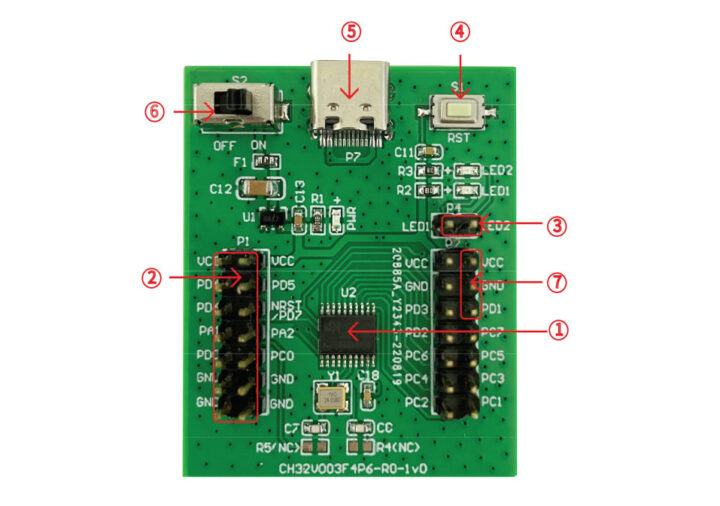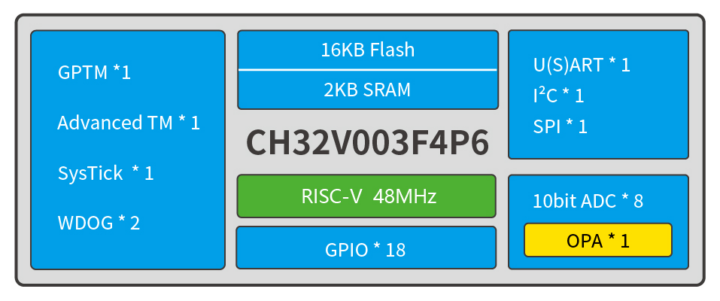WCH CH32V003 is a new ultra-cheap RISC-V microcontroller (MCU) clocked at 48 MHz with 2KB SRAM, 16KB flash, and a bunch of interfaces that sells for under 10 cents in quantities.
The MCU offers up to eighteen GPIOs, UART, SPI, I2C, an 8-channel 10-bit ADC, and several timers in TSSOP20, QFN20, SOP16, or SOP8 packages, and a small development board is also available.
WCH CH32V003 specifications:
- CPU – 32-bit “RISC-V2A” core up to 48 MHz
- Memory – 2KB SRAM
- Storage – 16KB flash
- Peripherals
- Up to 18x GPIO with interrupt support
- 1x USART interface
- 1x I2C
- 1x SPI
- 10-bit ADC up to 8 channels
- 1-Wire debug interface
- General purpose DMA controller
- Timers
- 16-bit advanced timer
- 16-bit general-purpose timer
- 2x watchdog timers
- 32-bit system timer
- Misc – 64-bit chip unique ID
- Supply voltage – 3.3/5V
- Low power modes – Sleep, standby
- Power on Reset (POR), programmable voltage detector
- Packages – TSSOP20, QFN20, SOP16, SOP8
Four parts are now available with CH32V003F4P6, CH32V003F4U6, CH32V003A4M6, and CH32V003J4M6 with most of the same specifications except for a different number of GPIOs and different packages.
WCH provides an SDK with C code samples for all interfaces using the usual MounRiver Studio IDE for development. There’s also a small development board based on CH32V003F4P6 to help engineers evaluate the solution. Right now the documentation is only available in Chinese, but the comments in the source are all in English, at least the files I’ve checked, so it could help. You’ll find all the aforementioned resources on the product page.

I got pricing information from a tweet by Patrick Yang, Technical Director of WCH, who claims that the CH32V003 RISC-V microcontroller sells for less than 10 cents. We just don’t know for which quantity that price is. It’s not the world’s cheapest microcontroller, but other MCUs in that price range often come with OTP (one-time programming) flash, while the CH32V003 is reprogrammable.
Goooood news!
The price of CH32V003 is less than 0.1 $
System clk: 48MHz
Other hardware resources are shown below.
WCH RISC-V MCU can achieve the better combination of performance and cost, due to the all IPs(RISC-V processor and other peripherals IP) are self-developed pic.twitter.com/jtV5GBKeZk— Patrick Yang (@patrick_riscv) October 13, 2022
We’re also told it’s available on LCSC, but right now, all I can see is the CH32V003F4P6-EVT-R0 development board going for $6.76. But if the MCU is that cheap, I’d expect to see sub-dollar boards from third parties in the next few months.

Jean-Luc started CNX Software in 2010 as a part-time endeavor, before quitting his job as a software engineering manager, and starting to write daily news, and reviews full time later in 2011.
Support CNX Software! Donate via cryptocurrencies, become a Patron on Patreon, or purchase goods on Amazon or Aliexpress






